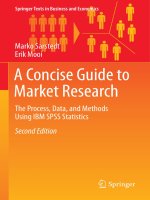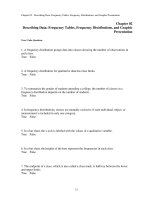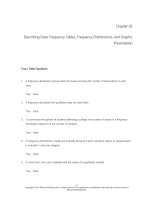Lecture Statistical techniques in business and economics - Chapter 14: Multiple regression
Bạn đang xem bản rút gọn của tài liệu. Xem và tải ngay bản đầy đủ của tài liệu tại đây (1.36 MB, 31 trang )
14 1
Copyright © 2004 by The McGrawHill Companies, Inc. All rights reserved.
14 2
When you have completed this chapter, you will be able to:
1.
2.
Understand the importance of an appropriate model
specification and multiple regression analysis
Comprehend the nature and technique of
multiple regression models and the concept of
partial regression coefficients.
3. Use the estimation techniques for multiple regression
models.
4.
Conduct an analysis of variance of an estimated model
Copyright © 2004 by The McGrawHill Companies, Inc. All rights reserved.
14 3
5.
6.
7.
8.
9.
Explain the goodness of fit of an estimated model.
Draw inferences about the assumed (true) model
though a joint test of hypothesis (F test) on the
coefficients of all variables
Draw inferences about the importance of the
independent variables through
tests of hypothesis (ttests)
Identify the problems raised, and the remedies
thereof, by the presence of multicollinearity
in the data sets
Identify the problems raised, and the remedies
thereof, by the presence of outliers/influential
observations in the data sets
Copyright © 2004 by The McGrawHill Companies, Inc. All rights reserved.
14 4
10. Identify the violation of model assumptions, including
linearity, homoscedasticity, autocorrelation, and
normality through simple diagnosic procedures.
11. Use some simple remedial measures in the presence of
violations of the model assumptions.
12. Write a research report on an investigation using
multiple regression analysis
13. Comprehend the concept of partial correlations and
its importance in multiple regression analysis
Copyright © 2004 by The McGrawHill Companies, Inc. All rights reserved.
14 5
14. Draw inferences about the importance of a subset of
the importance in multiple regression analysis
15. Use qualitative variables, as well as their interactions
with other independent variables through a joint
test of hypothesis
16. Apply some advanced diagnostic checks and remedies
in multiple regression analysis
Copyright © 2004 by The McGrawHill Companies, Inc. All rights reserved.
Multiple Regression Analysis
For two independent variables, the general form of
the multiple regression equation is:
y
a
b
1x 1 b2 x 2
x and x are the independent variables.
1
2
a is the yintercept.
b1 is the net change in y for each unit change in
x1 holding x2 constant. It is called
…a partial regression coefficient,
…a net regression coefficient, or
…just a regression coefficient.
Copyright © 2004 by The McGrawHill Companies, Inc. All rights reserved.
14 6
Multiple Regression Analysis
The general multiple regression with k
independent variables is given by:
y a b1x 1 b2 x 2
. . .
bk x k
The least squares criterion is used to develop this
equation.
Because determining b1, b2, etc. is very tedious, a
software package such as Excel or MINITAB is
recommended.
Copyright © 2004 by The McGrawHill Companies, Inc. All rights reserved.
14 7
Multiple Standard Error of Estimate
14 8
… is a measure of the effectiveness
of the
regression equation
… is measured in the same units as the
dependent variable
… it is difficult to determine what is a large value
and what is a small value of the standard error!
2
Σ( y − y )
n − ( k + 1)
Copyright © 2004 by The McGrawHill Companies, Inc. All rights reserved.
Multiple Regression and Correlation
Multiple Regression and Correlation
Assumptions
Assumptions
14 9
… the independent variables and the dependent variables
have a linear relationship
… the dependent variable must be continuous and
at least intervalscale
… the variation in (y y) or residual must be the same for all
values of y.
When this is the case, we say the difference exhibits
homoscedasticity
… the residuals should follow the normal distribution
with mean of 0
… successive values of the dependent variable must be
uncorrelated
Copyright © 2004 by The McGrawHill Companies, Inc. All rights reserved.
The AVOVA Table
The AVOVA Table
14 10
… reports the variation in the
dependent variable
… the variation is divided into two components:
a. … the Explained Variation is that accounted for
by the set of independent variable
b. … the Unexplained or Random Variation
is not accounted for by the independent
variables
Copyright © 2004 by The McGrawHill Companies, Inc. All rights reserved.
Correlation Matrix
Correlation Matrix
A correlation matrix is used
to show all possible
simple correlation coefficients among the
variables
…the matrix is useful for locating
correlated independent variables.
… it shows how strongly
each independent variable
is correlated
with the
dependent variable.
Copyright © 2004 by The McGrawHill Companies, Inc. All rights reserved.
14 11
14 12
Global Test
The global test is
used to investigate whether any of
the independent variables
have significant coefficients.
The hypotheses are:
H0 :
1
2
...
k
0
H 1 : Not all s equal 0
… continued
Copyright © 2004 by The McGrawHill Companies, Inc. All rights reserved.
Global Test
14 13
… continued
The test statistic is the …
F distribution with k (number of
independent variables)
and
n(k+1) degrees of freedom,
where n is the sample size
Copyright © 2004 by The McGrawHill Companies, Inc. All rights reserved.
Test for Individual Variables
Test for Individual Variables
14 14
This test is…
used to determine which independent variables
have nonzero regression coefficients
… the variables that have zero regression coefficients
are usually dropped from the analysis
… the test statistic is the t distribution with
n(k+1) degrees of freedom.
Copyright © 2004 by The McGrawHill Companies, Inc. All rights reserved.
14 15
A market researcher for Super Dollar Super
Markets is studying the yearly amount
families of four or more spend on
food.
Three independent variables are thought to be
related to yearly food expenditures (Food).
Those variables are:
… total family income (Income) in $00,
… size of family (Size), and
… whether the family has children in college (College)
Copyright © 2004 by The McGrawHill Companies, Inc. All rights reserved.
14 16
… continued
Note: … the following regarding the regression equation
… the variable college is called
a dummy or indicator variable.
(It can take only one of two
possible outcomes, i.e. a child is a
college student or not)
Other examples of dummy variables include…
… gender
… the part is acceptable or unacceptable
… the voter will or will not vote for the incumbent
We usually code one value of the dummy variable
as “1” and the other “0”
Copyright © 2004 by The McGrawHill Companies, Inc. All rights reserved.
14 17
… continued
Family
Food
Income
Size
1
3900
376
4
0
2
5300
515
5
1
3
4300
516
4
0
4
4900
468
5
0
5
6400
538
6
1
6
7300
626
7
1
7
4900
543
5
0
8
5300
437
4
0
9
6100
608
5
1
10
6400
513
6
1
11
7400
493
6
1
12
5800
563
5
0
Copyright © 2004 by The McGrawHill Companies, Inc. All rights reserved.
Student
14 18
… continued
Use a computer software package, such as
MINITAB or Excel,
to develop a correlation matrix.
From the analysis provided by MINITAB,
write out the regression equation:
What food expenditure would you estimate
What food expenditure would you estimate
for a family of 4, with no college students,
for a family of 4, with no college students,
and an income
and an income
of $50,000 (which
of $50,000 (which
is input as 500)?
is input as 500)?
Copyright © 2004 by The McGrawHill Companies, Inc. All rights reserved.
14 19
… continued
The regression equation is
Food = 954 + 1.09 Income + 748 Size + 565 Student
Predictor
Constant
Income
Size
Student
Coef
954
1.092
748.4
564.5
SE Coef
1581
3.153
303.0
495.1
S = 572.7
R-Sq = 80.4%
T
0.60
0.35
2.47
1.14
P
0.563
0.738
0.039
0.287
R-Sq(adj) = 73.1%
Analysis of Variance
Source
Regression
Residual Error
Total
DF
3
8
11
SS
10762903
2623764
13386667
MS
3587634
327970
F
10.94
y = 954 +1.09x11 + 748x
+ 748x22 + 565x
+ 565x33
y = 954 +1.09x
Copyright © 2004 by The McGrawHill Companies, Inc. All rights reserved.
P
0.003
14 20
… continued
The regression equation is
Food = 954 + 1.09 Income + 748 Size + 565 Student
Predictor Coef SE Coef T
P
Constant
954
1581 0.60 0.563
Income
1.092 3.153 0.35 0.738
Size
748.4 303.0 2.47 0.039
Student
564.5 495.1 1.14 0.287
S=572.7 R-Sq = 80.4%
R-Sq(adj) = 73.1%
Analysis of Variance
Source
DF
SS
MS
F
Regression
3
10762903 3587634 10.94
Residual Error
8
2623764 327970
Total
11
13386667
From the regression
From the regression
output we note:
output we note:
The coefficient of
The coefficient of
determination
determination
is 80.4
is 80.4
percent.
percent.
P
This means that
0.003
more than 80 percent of the variation
in the amount spent on food
is accounted for
by the
variables income, family size, and student
Copyright © 2004 by The McGrawHill Companies, Inc. All rights reserved.
14 21
… continued
The regression equation is
Food = 954 + 1.09 Income + 748 Size + 565 Student
Predictor Coef SE Coef T
P
Constant
954
1581 0.60 0.563
Income
1.092 3.153 0.35 0.738
Size
748.4 303.0 2.47 0.039
Student
564.5 495.1 1.14 0.287
An additional family
An additional family
member will
member will
increase the amount
increase the amount
spent per year on
spent per year on
food by $748
food by $748
S=572.7 R-Sq = 80.4%
R-Sq(adj) = 73.1%
Analysis of Variance
Source
DF
SS
MS
F
Regression
3
10762903 3587634 10.94
Residual Error
8
2623764 327970
Total
11
13386667
A family with a
A family with a
college student will
college student will
spend $565 more
spend $565 more
per year on food
per year on food
than those without
than those without
a college student
a college student
Copyright © 2004 by The McGrawHill Companies, Inc. All rights reserved.
P
0.003
14 22
… continued
The correlation matrix is as follows:
The correlation matrix is as follows:
Food
Income
Size
Income
0.587
Size
0.876
0.609
Student
0.773
0.491
0.743
The strongest correlation between
The strongest correlation between
the dependent variable (Food) and
the dependent variable (Food) and
an independent variable is between
an independent variable is between
family size and amount spent on
family size and amount spent on
food.
food.
None of the correlations among the
None of the correlations among the
independent variables should cause
independent variables should cause
problems.
problems.
All are between –.70 and .70
All are between –.70 and .70
Copyright © 2004 by The McGrawHill Companies, Inc. All rights reserved.
14 23
… continued
Find the estimated food expenditure for
a family of 4 with a
$500 (that is
$50,000) income
and no college student.
The regression equation is…
Food = 954 + 1.09 Income + 748 Size + 565 Student
y = 954 + 1.09(500) + 748(4) + 565(0)
= $4,491
Copyright © 2004 by The McGrawHill Companies, Inc. All rights reserved.
14 24
… continued
The regression equation is
Food = 954 + 1.09 Income + 748 Size + 565
Student
Predictor Coef SE Coef T
P
Constant
954
1581 0.60 0.563
Income
1.092 3.153 0.35 0.738
Size
748.4 303.0 2.47 0.039
Student
564.5 495.1 1.14 0.287
S=572.7 R-Sq = 80.4%
R-Sq(adj) = 73.1%
Analysis of Variance
Source
DF
SS
MS
F
Regression
3
10762903 3587634 10.94
0.003
Residual Error 8
2623764 327970
Total
11
13386667
Conduct a global test of
hypothesis to determine
if any of the regression
coefficients are not zero
H0 : 1 2 3 0
H1 :
at least one
H0 is rejected if F>4.07
…from the MINITAB
output,
the
computed value
Decision: H0 is rejected. of F is 10.94
P
Not all the regression coefficients are zero
Copyright © 2004 by The McGrawHill Companies, Inc. All rights reserved.
14 25
… continued
Conduct an individual test
to
determine which
coefficients are not zero
(This is the
0
H 0: 2
0 H 1 :hypothesis for the
2
independent variable
… Using the 5% level of significance,
family size)
The regression equation is
Food = 954 + 1.09 Income + 748 Size
+ 565 Student
Predictor Coef SECoef
T
P
Constant
954
1581 0.60 0.563
Income
1.092 3.153 0.35 0.738
Size
748.4 303.0 2.47 0.039
Student
564.5 495.1 1.14 0.287
reject H0 if the P
value<.05
From the MINITAB output,
From the MINITAB output,
the only significant variable is FAMILY (family size)
the only significant variable is FAMILY (family size)
using the Pvalues
using the Pvalues
(The other variables can be omitted from the
(The other variables can be omitted from the
model)
model)
Copyright © 2004 by The McGrawHill Companies, Inc. All rights reserved.









